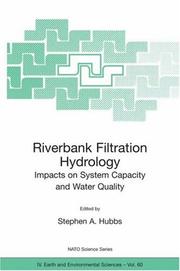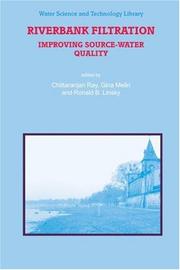| Listing 1 - 10 of 33 | << page >> |
Sort by
|
Book
Abstract | Keywords | Export | Availability | Bookmark
 Loading...
Loading...Choose an application
- Reference Manager
- EndNote
- RefWorks (Direct export to RefWorks)
Water --- Purification --- Riverbank filtration
Book
Year: 2005 Publisher: Reston, Va. : U.S. Geological Survey,
Abstract | Keywords | Export | Availability | Bookmark
 Loading...
Loading...Choose an application
- Reference Manager
- EndNote
- RefWorks (Direct export to RefWorks)
Water --- Microbial contamination --- Purification --- Riverbank filtration --- Pollution
Book
Year: 2006 Publisher: Reston, Va. : U.S. Dept. of the Interior, U.S. Geological Survey,
Abstract | Keywords | Export | Availability | Bookmark
 Loading...
Loading...Choose an application
- Reference Manager
- EndNote
- RefWorks (Direct export to RefWorks)
Groundwater --- Water --- Quality --- Purification --- Riverbank filtration
Book
Year: 2005 Publisher: Reston, Va. : U.S. Geological Survey,
Abstract | Keywords | Export | Availability | Bookmark
 Loading...
Loading...Choose an application
- Reference Manager
- EndNote
- RefWorks (Direct export to RefWorks)
Water --- Drugs --- Pesticides --- Oxygen --- Hydrogen --- Purification --- Riverbank filtration --- Environmental aspects --- Environmental aspects --- Isotopes --- Isotopes
Book
Year: 2005 Publisher: Reston, Va. : U.S. Geological Survey,
Abstract | Keywords | Export | Availability | Bookmark
 Loading...
Loading...Choose an application
- Reference Manager
- EndNote
- RefWorks (Direct export to RefWorks)
Water --- Drugs --- Pesticides --- Oxygen --- Hydrogen --- Purification --- Riverbank filtration --- Environmental aspects --- Isotopes
Book
Year: 1988 Publisher: Gembloux : IRSIA (Centre de Recherche et de Promotion Forestières),
Abstract | Keywords | Export | Availability | Bookmark
 Loading...
Loading...Choose an application
- Reference Manager
- EndNote
- RefWorks (Direct export to RefWorks)
Riverbanks --- plant population --- Erosion control plants --- vegetation. --- vegetation --- Riverbank protection --- Belgium --- Belgium
Book
ISBN: 9400700253 9400700393 9400700261 Year: 2011 Publisher: Dordrecht, The Netherlands : Springer,
Abstract | Keywords | Export | Availability | Bookmark
 Loading...
Loading...Choose an application
- Reference Manager
- EndNote
- RefWorks (Direct export to RefWorks)
Riverbank filtration is a low cost, yet efficient water treatment technology. It has most potential to provide safe drinking water to large cities located along rivers or lakes. In particular, it is ideal for large population centres in developing countries, where the cost of building extensive treatment facilities is prohibitive. Water filtration can be successfully implemented using naturally occurring sand and gravel along the river/lake banks. The cost of water produced by this means is much lower than that of water treated in conventional treatment plants. Authored by a multi-disciplinary team of experts, this volume addresses the scientific basis of the filtration process, and also numerous topics of importance for the planning, technical realization, and security of such plants. Their application for the removal of relevant chemical pollutants and a variety of pathogens is analysed in detail.
Civil & Environmental Engineering --- Geography --- Engineering & Applied Sciences --- Earth & Environmental Sciences --- Environmental Engineering --- Physical Geography --- Water --- Purification --- Riverbank filtration --- Filtration --- Earth sciences. --- Water-supply. --- Geochemistry. --- Hydrogeology. --- Geotechnical engineering. --- Geomorphology. --- Earth Sciences. --- Water Industry/Water Technologies. --- Geotechnical Engineering & Applied Earth Sciences. --- Hydrology --- Hydraulic engineering. --- Chemical composition of the earth --- Chemical geology --- Geological chemistry --- Geology, Chemical --- Chemistry --- Earth sciences --- Engineering, Hydraulic --- Engineering --- Fluid mechanics --- Hydraulics --- Shore protection --- Engineering, Geotechnical --- Geotechnics --- Geotechnology --- Engineering geology --- Geomorphic geology --- Physiography --- Physical geography --- Landforms --- Availability, Water --- Water availability --- Water resources --- Natural resources --- Public utilities --- Water resources development --- Water utilities --- Geohydrology --- Geology --- Groundwater --- Riverbank filtration. --- Riverbank infiltration

ISBN: 1402039360 1402039379 9786611242749 1281242748 1402039387 Year: 2006 Volume: v. 60 Publisher: Dordrecht ; [Great Britain] : Springer,
Abstract | Keywords | Export | Availability | Bookmark
 Loading...
Loading...Choose an application
- Reference Manager
- EndNote
- RefWorks (Direct export to RefWorks)
Riverbank Filtration (RBF) has gained popularity in the past decade as an excellent source of high quality water for public water supply. This text compliments the existing literature on RBF water quality, and provides much-need guidance in the design and operation of RBF facilities. RBF has proven effective in many hydrogeological settings worldwide, and can be an excellent solution to water supply problems in both developed and developing countries. Topics covered include surface stream hydrology, particle clogging, and biological/geochemical processes. Data and case histories are provided from dozens of installations, providing much-needed practical information regarding RBF design, operation, and performance. This book provides the necessary tools to evaluate potential RBF sites, and is a must-have if you are considering RBF as a source of water supply.
Streamflow --- Hydrology --- Filters and filtration --- Cours d'eau --- Hydrologie --- Filtres et filtration --- Congresses. --- Débit --- Congrès --- Streamflow. --- Physical Geography --- Geography --- Earth & Environmental Sciences --- Débit --- Congrès --- EPUB-LIV-FT LIVTERRE Riverbank SPRINGER-B filtration hydrology --- Flow, Stream --- River flow --- Riverflow --- Stream flow --- Earth sciences. --- Hydrology. --- Hydrogeology. --- Civil engineering. --- Earth Sciences. --- Hydrology/Water Resources. --- Civil Engineering. --- Runoff --- Stream measurements --- Hydraulic engineering. --- Engineering --- Public works --- Engineering, Hydraulic --- Fluid mechanics --- Hydraulics --- Shore protection --- Aquatic sciences --- Earth sciences --- Hydrography --- Water --- Geohydrology --- Geology --- Groundwater --- Riverbank filtration hydrology

ISBN: 0306481545 1402011334 Year: 2003 Publisher: Dordrecht : Springer Netherlands,
Abstract | Keywords | Export | Availability | Bookmark
 Loading...
Loading...Choose an application
- Reference Manager
- EndNote
- RefWorks (Direct export to RefWorks)
Chittaranjan Ray, Ph. D. , P. E. University of Hawaii at Mãnoa Honolulu, Hawaii, United States Jürgen Schubert, M. Sc. Stadtwerke Düsseldorf AG Düsseldorf, Germany Ronald B. Linsky National Water Research Institute Fountain Valley, California, United States Gina Melin National Water Research Institute Fountain Valley, California, United States 1. What is Riverbank Filtration? The purpose ofthis book is to show that riverbank filtration (RBF) isa low-cost and efficient alternative water treatment for drinking-water applications. There are two immediate benefits to the increased use of RBF: Minimized need for adding chemicals like disinfectants and coagulants to surface water to control pathogens. Decreased costs to the community without increased risk to human health. Butwhat,exactly, isRBF? In humid regions, river water naturally percolates through the ground into aquifers (which are layers of sand and gravel that contain water underground) during high-flow conditions. In arid regions, most rivers lose flow, and the percolating water passes through soil and aquifer material until it reaches the water table. During these percolation processes, potential contaminants present in river water are filtered and attenuated. If there are no other contaminants present in the aquifer or ifthe respective contaminants are present at lower concentrations, the quality of water in the aquifer can be ofhigher quality than that found in theriver. In RBF, production wells — which are placed near the banks ofrivers —pump large quantities ofwater.
Environment. --- Geochemistry. --- Hydrogeology. --- Air pollution. --- Water pollution. --- Waste Water Technology / Water Pollution Control / Water Management / Aquatic Pollution. --- Atmospheric Protection/Air Quality Control/Air Pollution. --- Water --- Purification --- Riverbank filtration. --- Aquatic pollution --- Fresh water --- Fresh water pollution --- Freshwater pollution --- Inland water pollution --- Lake pollution --- Lakes --- Reservoirs --- River pollution --- Rivers --- Stream pollution --- Water contamination --- Water pollutants --- Water pollution --- Pollution --- Waste disposal in rivers, lakes, etc. --- Air --- Air contaminants --- Air pollutants --- Air pollution --- Air pollution control --- Air toxics --- Airborne pollutants --- Atmosphere --- Contaminants, Air --- Control of air pollution --- Pollutants, Air --- Toxics, Air --- Air quality --- Atmospheric deposition --- Geohydrology --- Geology --- Hydrology --- Groundwater --- Chemical composition of the earth --- Chemical geology --- Geological chemistry --- Geology, Chemical --- Chemistry --- Earth sciences --- Riverbank filtration --- Riverbank infiltration --- Control --- Filtration
Book
Year: 2021 Publisher: Basel, Switzerland MDPI - Multidisciplinary Digital Publishing Institute
Abstract | Keywords | Export | Availability | Bookmark
 Loading...
Loading...Choose an application
- Reference Manager
- EndNote
- RefWorks (Direct export to RefWorks)
Mechanical and hydraulic soil properties are strongly affected by the degree of saturation, with important consequences for earthen embankments, soil–vegetation–atmosphere interactions, geoenvironmental applications, and risk mitigation. The presence of sloping ground surfaces is common. In slightly inclined natural slopes, susceptible to deep landslides, the unsaturated condition of shallow soil horizons affects deep pore water pressures and, therefore, global stability. The stability of steep mountains covered by shallow deposits is often guaranteed by a shear strength contribution related to the unsaturated condition. In this case, the degree of saturation plays a key role in determining which rainfall events can act as landslide triggers, consequently controlling the post-failure evolution. Partial saturation is the basic characteristic of soils used as construction materials of geo-structures such as levees, dikes, and dams. It governs the structure behavior during construction phases, in serviceability, and in extreme scenarios. Hoping to provide a bridge between theoretical research and practical applications, this Special Issue collects quality contributions related to natural and artificial slopes under unsaturated conditions, focusing on aspects such as: water retention and transport properties, mechanical behavior, advances in experimental methods, laboratory and in situ characterization, field monitoring, geotechnical and geophysical field tests, landslide investigation and prevention, the design and maintenance of engineered slopes, and the constitutive and numerical modeling of hydro-mechanical behavior.
landslide --- soil slide --- LAMP --- soil water content --- soil moisture --- monitoring --- calibration --- installation --- rainfall --- debris flow --- in situ characterization --- triaxial tests --- unsaturated conditions --- unsaturated slope --- Ruedlingen field experiment --- lateral resistance --- limit equilibrium solution --- riverbank --- unsaturated soils --- water retention curve --- unsaturated permeability curve --- transient seepage --- slope stability --- pyroclastic soils --- infiltration --- capillary barriers --- stability analysis --- water retention --- suction --- silty sands --- commercial experimental techniques --- n/a
| Listing 1 - 10 of 33 | << page >> |
Sort by
|

 Search
Search Feedback
Feedback About UniCat
About UniCat  Help
Help News
News